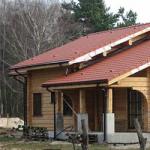Exterior walls
In buildings with a load-bearing frame in the form of frame-shelf systems, the external walls are arranged as non-load-bearing, supported floor by floor elements and performing enclosing functions to protect the internal volume of buildings from temperature changes, noise and atmospheric influences. For the construction of such walls, small stones or blocks of lightweight concrete(for example from cellular concrete or gas silicate) or other low thermal conductivity materials that provide the required thermal resistance to external walls.

Rice. 27.10.1. Option for constructing and supporting homogeneous non-load-bearing walls made of lightweight concrete blocks on the floors in houses with frame-shelving systems:
a – blank wall; b – wall with window opening

Rice. 27.10.2. A variant of constructing a non-load-bearing homogeneous wall made of cellular concrete blocks, supported floor by floor on reinforced concrete slabs floors (section 2 – 2; Fig. 27.1.5)
A B C)
Rice. 27.10.3. Options for constructing and supporting external non-load-bearing homogeneous walls made of cellular concrete blocks in the wall part (a) and in places with openings (b, c)
The walls can be homogeneous, that is, made of the same material, or heterogeneous. Heterogeneous walls are arranged layered in thickness, i.e. in such walls, to reduce their thickness and mass, a layer is laid between the inner and outer layers effective lung insulation, the thickness of which is determined by calculations for thermal protection. The outside of the walls is covered with a protective finishing layer, for example, a layer of plaster 20-30 mm thick, or facing bricks, or special facing stones or slabs, and inside with a finishing plaster layer 10-15 mm thick. In Fig. 27.10.1. – 10.27.11. Shown are options for constructive solutions for external walls and nodes for their support on the floors and adjoining to other frame elements.

Rice. 27.10.4. Option for constructing and supporting an external non-load-bearing non-uniform wall made of lightweight concrete blocks and effective insulation with cladding facade tiles(wall with window opening):
a – section; b – plan; 1 – fittings

Rice. 27.10.5. Option for constructing and supporting an external curtain wall made of gas silicate blocks with brick cladding:
C1 – reinforcing mesh

Rice. 27.10.6. Option for constructing an external non-load-bearing wall made of cellular concrete blocks with brick lining and a junction of the wall to the frame column
Rice. 27.10.7. A variant of a unit for supporting an external non-load-bearing homogeneous wall made of lightweight concrete blocks on a floor slab.
Rice. 27.10.8. Option for connecting an external non-load-bearing homogeneous wall made of cellular concrete blocks to a corner column

Rice. 27.10.9. Option for joining a curtain wall made of cellular concrete blocks to a frame column

Rice. 27.10.10. Option for angular connection of non-load-bearing cellular concrete longitudinal and transverse walls to the frame column
Rice. 27.10.11. Device option expansion joint in external curtain walls
Partitions
Partitions in residential buildings with a load-bearing frame in the form of prefabricated frame-shelving systems can be constructed both large-panel and from small-sized piece elements, and with prefabricated-monolithic or monolithic frame options - only from small-sized piece elements (in connection with the technology of constructing these frames, i.e. connection with the need to install supporting and formwork-ceiling equipment on the floor of the previous floor for the installation of the floor of the next highest floor).
At the same time, interior and inter-apartment partitions can be constructed from the same small-sized piece elements as in frameless houses, but most often they are constructed from gas silicate or cellular concrete slabs or framed plasterboard, and the partitions separating wet rooms, including sanitary facilities, are made from moisture-resistant materials, for example, red brick. In Fig. 27.11.1. – 27.11.8. Shown are options for constructive solutions for partitions made of small-sized piece elements and the nodes of their support on the floors and abutments to walls and ceilings.

Rice. 27.11.1. Option of junction and fastening unit ( cross section) two-layer combined (from cellular concrete and brick layers) partition to top floor:
1 – caulk; 2 – dowel; 3 – sizing with fabric; 4 – retaining bracket; 5 - reinforcement cages; 6 – antiseptic wooden beam with a section of 40 x 40 mm along the length of the partition; 7 – plaster

Rice. 27.11.2. Option for the junction and fastening (plan) of a two-layer combined partition (from cellular concrete and brick layers) to the wall:
1 – caulk; 2 – dowel; 3 – sizing with fabric; 4 – retaining bracket; 5 – reinforcement cages; 6 – antiseptic wooden beam with a section of 40 x 100 mm along the height of the partition; 7 – plaster

Figure 27.11.3. Option for joining and fastening double partitions to the upper (ceiling) floor:
1 – overlap; 2 – retaining bracket; 3 – dowel; 4 – partition; 5 - reinforcement cage

Rice. 27.11.4. Option for joining and fastening double partitions to vertical wall(to Fig. 27.11.2.):
1 – wall; 2 – partition; 3 - dowel; 4,5,6 – reinforcement cages at the level of the retaining bracket; 7 – retaining bracket

Rice. 27.11.5. A variant of the design of a retaining bracket, the length of which is set depending on the thickness of the partition (in the figure, the length of the bracket is 265 mm, to Fig. 27.11.1., 27.11.2 and 27.11.4.)

Rice. 27.11.6. A variant of the unit for supporting and connecting a two-layer partition made of cellular concrete blocks to the floor slab. Between the floor slab and the top of the partition there is a flexible elastic gasket 10 mm thick

Rice. 27.11.7. Options for junction points and fastening with separate retaining brackets of two-layer brick and combined partitions to floor slabs and their support on the floors:
1 – floor slabs; 2 – sizing with fabric; 3 – retaining brackets; 4 - caulk; 5 – reinforcement cages; 6 – plaster; 7 – brick; 8 – plinth; 9 - cement-sand mortar. The gap between the floor slab (and itself) and the partition is sealed with caulk

Rice. 27.11.8. Options for junction points and fastening of two-layer partitions to walls with separate retaining brackets (in plan):
1 – retaining brackets; 2 – plaster; 3 – cadmium nails; 4 – sizing with fabric; 5 – reinforcement cages. Gaps between walls and partitions are sealed with caulk
Stairs and elevators
The walls of staircase and elevator units are arranged according to the type of frame, i.e. prefabricated or monolithic, and they, in addition to enclosing functions, absorb loads from elements of stairs and ceilings and at the same time serve as vertical rigidity diaphragms.
Staircases are made of prefabricated large-element or large-panel Z-shaped profiles, and when monolithic version frame possible device monolithic stairs. The load-bearing elements of the stairs rest either on supporting ledges-tables in load-bearing elements frame, or secured by welding embedded parts in the load-bearing elements of the frame and stairs (Fig. 27.12.1. and 27.12.2.).
FRAMEWORK
In industrial construction, bricks are used to build: walls of buildings with a damp, aggressive environment; small industrial buildings; section of walls with a large number of
vom technological holes or openings; a variety of buildings in areas where brick is a local material.
Thickness brick walls depends on thermal requirements and is 250, 380 and 510 mm. Laying such walls is labor-intensive, which increases the cost and lengthens the construction period.
According to load perception, brick walls are divided into:
1. Bearers, forming the skeleton of the building. They are based on strip foundations, in places where beams or trusses are laid, they are reinforced from the inside with pilasters (Fig. 76, a, b). Within the walls of warehouses bulk materials They arrange inclined projections (buttresses) on the outside to absorb horizontal forces.
2. Self-supporting(Fig. 76, c, d), leaning against the columns of the frame. They are supported on foundation beams on top of a waterproofing layer. Walls of this design are most common in industrial construction.
3. Mounted(Fig. 78.5), supported on strapping beams located above the window openings.
Self-supporting brick walls to the frame columns (Fig. 76, e) secured with flexible ties every 1.2 m in height. Thickening in the corners of frame buildings (Fig. 76, e) prevents freezing of the walls.
Brick wall plinths are plastered cement mortar or veneer ceramic tiles. Openings (up to 4.5 m wide) are covered with reinforced concrete
jumpers. The top of the wall ends with a cornice formed by overlapping rows of bricks, or a parapet.
To increase the decorative effect of the masonry, the seams on the facades are embroidered, giving them a convex or concave shape. On inner surface the seams are level with the plane of the wall.
DESIGN SOLUTIONS FOR PANEL WALLS IN INDUSTRIAL BUILDINGS.
JOINT CONSTRUCTIONS
Walls of heated buildings
arranged as hinged (with a panel thickness of 160 mm) or self-supporting and self-supporting with a thickness of 240-300
For curtain walls(Fig. 81,a) are characterized by strip openings and support of over-window panels Fig. 81,c) on steel consoles. The same consoles are also necessary on blind sections of walls through 4.8-
6 m in height. Self-supporting 240-300
For self-supporting walls(Fig. 81.6) are characterized by individual openings 3-4.5 m wide and the support of the over-window panels on the partitions. The height of such walls depends on bearing capacity panels.
In mounted and self-supporting walls plinth panels(Fig. 81, d) are laid on the foundation beam along a layer of waterproofing made of cement mortar.
In the corners of the walls of heated buildings (Fig. 81.5), additional blocks are installed: see coursework
(Layout of panels in height (Fig. 82,a,b) perform so that one of the horizontal seams is located 600 mm from the column head. Below this mark, the panels are attached to the columns, above - to the covering structures. Top panel walls(Fig. 82.0, G) completes the parapet or cornice. shove it into a note)
Walls of unheated buildings They are carried out only as hinged ones from flat reinforced concrete panels 70 mm thick. The basement part of the walls is arranged in the same way as in heated buildings. The wall assemblies (Fig. 83, a) are made of elongated panels laid in the direction of the longitudinal walls. The panels of the end walls are fixed to the half-timbered posts, and the longitudinal walls - to the columns of the frame. The upper part of the walls has a parapet or cornice (Fig. 83.6) made of steel profiles welded to the under-eaves panel.
Design of joints. The seams of large-panel walls are filled with elastic gaskets made of germite or poroizol and sealed with mastic (UM-40, UMS-50). Along the edges of the panel (Fig. 84,a, b) lay rigid gaskets that fix the thickness of the horizontal seams. Sealing joints with cement mortar is permitted as an exception.
Fastening panels to columns must be strong and flexible under temperature and sedimentary deformations of the walls.
The panels are fixed (Fig. 84,d, d, f, g) a bolt with a plate for three-layer panels, an anchor with a plate for a column spacing of 6 m,
Composition of the seriesDetail 1 Fastening the longitudinal or end wall to reinforced concrete column
Detail 2 Fastening the longitudinal wall to the steel column
Detail 3 Fastening the end wall to the reinforced concrete rectangular column of the middle row
Detail 4 Fastening the end wall to the reinforced concrete two-branch column of the middle row
Detail 5 Fastening the end wall to the middle row steel column
Detail 6 Fastening the longitudinal or end wall to the head of the reinforced concrete half-timbered column or to the steel half-timbered column
Detail 7 Fastening the end wall to the rafter beam
Detail 8 Fastening the end wall to the truss when pitched roof and the width of the lower chord of the truss 200 and 250 mm
Detail 9 Fastening the end wall to the truss with a pitched roof and the width of the lower chord of the truss being 300 and 350 mm
Detail 10 Fastening the end wall to the truss when flat roof
Detail 11 Fastening the longitudinal wall to the truss with an “o” tie and a flat roof
Detail 12 Fastening the longitudinal wall to the truss with a “250” tie and a flat roof
Detail 13 Fastening the parapet of the longitudinal wall to the covering slabs with an “o” connection and a pitched roof
Detail 14 Fastening the parapet of the longitudinal wall to the covering slabs with the “250” connection and a pitched roof. Wall thickness 250 mm
Detail 15 Attaching the parapet of the longitudinal wall to the covering slabs with a “250” connection and a pitched roof. Wall thickness 380 and 510 mm
Detail 16 Fastening the parapet of the longitudinal wall to the covering slabs with a span of 12 m along the axis of the half-timbered column and the “o” reference and the pitched roof
Detail 17 Fastening the parapet of the longitudinal wall to the covering slabs with a span of 12 m along the axis of the half-timbered column with a “250” reference and a pitched roof. Wall thickness 250 mm
Detail 18 Fastening the parapet of the longitudinal wall to the covering slabs with a span of 12 m along the axis of the half-timbered column with a “250” reference and a pitched roof. Wall thickness 380 and 510 mm
Detail 19 Fastening the parapet of the longitudinal wall to the covering slabs with an “o” connection and a flat roof
Detail 20 Fastening the parapet of the longitudinal wall to the covering slabs with the “250” connection and a flat roof. Wall thickness 250 mm
Detail 21 Fastening the parapet of the longitudinal wall to the covering slabs with a 250 tie and a flat roof / Wall thickness 380 and 510 mm
Detail 22 Fastening the parapet of the longitudinal wall to the covering slabs with a span of 12 m along the axis of the half-timbered column with an “o” connection and a flat roof
Detail 23 Fastening the parapet of the longitudinal wall to the covering slabs with a span of 12 m along the axis of the half-timbered column with a reference “250” and a flat roof. Wall thickness 250 mm
Detail 24 Fastening the parapet of the longitudinal wall to the covering slabs with a span of 12 m along the axis of the half-timbered column with a reference “250” and a flat roof. Wall thickness 380 and 510 mm
Detail 25 Fastening the end wall parapet to the covering slabs
Detail 26 Supporting the covering slabs on the longitudinal wall with a pitched roof. Wall thickness 380 mm
Detail 27 Supporting the covering slabs on the longitudinal wall with a pitched roof. Wall thickness 510 mm
Detail 28 Supporting the covering slabs on the longitudinal wall with a flat roof. Wall thickness 380 mm
Detail 29 Supporting the covering slabs on the longitudinal wall with a flat roof. Wall thickness 510 mm
Detail 30 Supporting a rafter beam with a span of 12 m on a pilaster
Detail 31 Supporting a rafter beam with a span of 18 m on a pilaster
Detail 32 Attaching the cornice of the longitudinal wall to the covering slabs with an “o” connection and a pitched roof
Detail 33 Attaching the eaves of the longitudinal wall to the covering slabs with a “250” connection and a pitched roof
Detail 34 Attaching the end wall cornice to the covering slabs
Detail 35 Attaching the eaves of the longitudinal wall to the covering slabs with an “o” tie and a flat roof
Detail 36 Attaching the eaves of the longitudinal wall to the covering slabs with the “250” connection and a flat roof
Detail 37 Fastening the end wall to steel trusses along the axis of the middle row column
Sheet A Steel elements from MK-1 to MK-11
Sheet B Steel elements from MK-13 to MK-16; from MK-18 to MK-22
Sheet B Steel elements from MK-23 to MK-28
Sheet G Steel elements from MK-29 to MK-32
Sheet D Steel specification for elements MK-1 to MK-24
Sheet E Steel specification for elements MK-25 to MK-32
Issue 3. Connections between brick walls and reinforced concrete frame. Working drawings
The price for this document is not yet known. Click the "Buy" button and place your order and we will send you the price.
Distributing regulatory documentation since 1999. We punch checks, pay taxes, accept all legal forms of payment without additional interest. Our clients are protected by law. LLC "CNTI Normocontrol"
Our prices are lower than other places because we work directly with document providers.
Delivery methods
- Urgent Express delivery(1-3 days)
- Courier delivery (7 days)
- Pickup from the Moscow office
- Russian Post
2.430-20.3 01 Unit 1. Fastening a longitudinal or end wall to a reinforced concrete column
2.430-20.3 02 Unit 2, 2a. Fastening the end wall to the reinforced concrete rectangular column of the middle row
2.430-20.3 03 Unit 3. Fastening the end wall to the reinforced concrete two-branch column of the middle row
2.430-20.3 04 Unit 4. Fastening the end wall to the truss with a pitched roof
2.430-20.3 05 Unit 5. Fastening the longitudinal wall to the truss with reference “0” and a flat roof
2.430-20.3 06 Node 6, 6a, 6b. Fastening the parapet of a longitudinal wall to the covering slabs with reference “0” and a pitched roof
2.430-20.3 07 Unit 7. Fastening the parapet of the longitudinal wall to the covering slabs with a “250” connection and a pitched roof. Wall thickness 250 mm
2.430-20.3 08 Node 8, 8a. Fastening the parapet of a longitudinal wall to the covering slabs with a “250” connection and a pitched roof. Wall thickness 380 and 510 mm
2.430-20.3 09 Node 9, 9a, 9b. Fastening the parapet of a longitudinal wall to the covering slabs with a span of 12 m along the axis of the half-timbered column with reference “0” and a pitched roof
2.430-20.3 10 Unit 10. Fastening the parapet of the longitudinal wall to the covering slabs with a “250” connection and a pitched roof. Wall thickness 250 mm
2.430-20.3 11 Node 11, 11a. Fastening the parapet of the longitudinal wall to the covering slabs with a span of 12 m. With a “250” connection and a pitched roof. Wall thickness 380 and 510 mm
2.430-20.3 12 Node 12, 12a, 12b. Fastening the parapet of a longitudinal wall to the covering slabs with reference “0” and a flat roof
2.430-20.3 13 Unit 13. Fastening the parapet of the longitudinal wall to the covering slabs with a “250” connection and a flat roof. Wall thickness 250 mm
2.430-20.3 14 Node 14, 14a. Fastening the parapet of a longitudinal wall to the covering slabs with a “250” connection and a flat roof. Wall thickness 380 and 510 mm
2.430-20.3 15 Node 15, 15a, 15b. Fastening the parapet of a longitudinal wall to the covering slabs with a span of 12 m along the axis of the half-timbered column with reference “0” and a flat roof
2.430-20.3 16 Unit 16. Fastening the parapet of the longitudinal wall to the covering slabs with a span of 12 m along the axis of the half-timbered column with reference “250” and a flat roof. Wall thickness 250 mm
2.430-20.3 17 Unit 17. Fastening the parapet of the longitudinal wall to the covering slabs with a span of 12 m along the axis of the half-timbered column with reference “250” and a flat roof. Wall thickness 380 and 510 mm
2.430-20.3 18 Unit 18. Fastening the end wall parapet to the covering slabs
2.430-20.3 19 Unit 19. Supporting the covering slabs on the longitudinal wall with a pitched roof. Wall thickness 380 mm
2.430-20.3 20 Unit 20. Supporting the covering slabs on the longitudinal wall with a pitched roof. Wall thickness 510 mm
2.430-20.3 21 Unit 21. Supporting the covering slabs on the longitudinal wall with a flat roof. Wall thickness 380 mm
2.430-20.3 22 Unit 22. Supporting the covering slabs on the longitudinal wall with a flat roof. Wall thickness 510 mm
2.430-20.3 23 Node 23. Supporting a rafter beam with a span of 12 m on a pilaster
2.430-20.3 24 Node 24. Fastening the eaves of the longitudinal wall to the covering slabs with reference “0” and a pitched roof
2.430-20.3 25 Node 25. Fastening the eaves of the longitudinal wall to the covering slabs with a “250” connection and a pitched roof
2.430-20.3 26 Unit 26. Fastening the end wall cornice to the covering slabs




